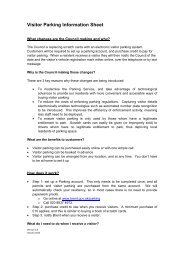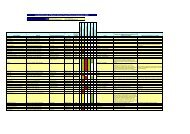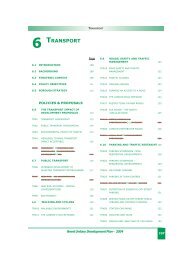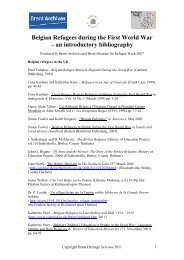Planning for Sport and Active Recreation Facilities ... - Brent Council
Planning for Sport and Active Recreation Facilities ... - Brent Council
Planning for Sport and Active Recreation Facilities ... - Brent Council
You also want an ePaper? Increase the reach of your titles
YUMPU automatically turns print PDFs into web optimized ePapers that Google loves.
• London Borough of <strong>Brent</strong> Capital Funds<br />
• Prudential Borrowing<br />
• Capital receipts from sale of l<strong>and</strong><br />
• Site development (in the case of Bridge Park it has been<br />
identified that this could be funded through housing<br />
development on the site.)<br />
• External funding (such as the lottery)<br />
• Section 106 (increasing amount of money generated<br />
<strong>for</strong> sport)<br />
• Joint Ventures between London Boroughs<br />
• Commercial Enterprise<br />
• Sponsorship<br />
• Local Community Funds<br />
• 2012 legacy, this may bring about new funding streams<br />
previously not available<br />
• <strong>Sport</strong>s Clubs who may have access to more external<br />
funding<br />
• Revenue Support from the council to help with<br />
management of facilities<br />
• <strong>Sport</strong>s National Governing Bodies<br />
• Building Schools <strong>for</strong> the Future (strategic need not just<br />
school needs)<br />
• Regeneration/Enterprise Fund<br />
• Public/Private Partnerships<br />
• Trusts<br />
• Partnership Delivery through education/health etc.<br />
• Opportunities presented by planning policy changes to<br />
fund major sporting infrastructure developments.<br />
• Cultural Industries/Art funding streams<br />
Building Schools <strong>for</strong> the Future<br />
The Government has pledged to replace or renew all<br />
secondary schools, including special schools, over the<br />
next 10 to 15 years under the programme name of<br />
Chapter Nine Delivery<br />
Building Schools <strong>for</strong> the Future (BSF). It is anticipated<br />
that any new build schools will be funded using the PFI<br />
process, with refurbishment funded by traditional capital<br />
funding mechanisms. This programme has a major part<br />
to play in building new sports facilities. With less funding<br />
being available through the lottery <strong>and</strong> <strong>Sport</strong> Engl<strong>and</strong>,<br />
the Building Schools <strong>for</strong> the Future programme may<br />
contain the only substantial source of investment that is<br />
needed to improve <strong>and</strong> provide new sports facilities.<br />
It is vital that this strategy takes into account the BSF<br />
programme <strong>and</strong> it helps to dictate what sports facilities<br />
are factored into the building of a new or renewed<br />
school. It is important that sport has an input into the BSF<br />
process from the outset to allow <strong>for</strong> the correct facilities<br />
to be strategically placed into areas of need that will serve<br />
the whole community not just the school. Community<br />
use is a key component to the BSF programme <strong>and</strong> this<br />
needs to be maximised. This means that decisions on the<br />
design of the building need to be considered carefully.<br />
The BSF programme is limited to providing sports facilities<br />
such as sports halls, dance/gymnastics studios, health<br />
<strong>and</strong> fitness, synthetic turf pitches, MUGA’s, tennis courts,<br />
netball courts, basketball courts, all weather cricket<br />
wickets, nets <strong>and</strong> pitches, grass football pitches, rugby<br />
pitches, <strong>and</strong> athletics facilities. The BSF programme is<br />
reluctant to provide facilities such as swimming pools as<br />
they are costly to maintain <strong>and</strong> manage. However there<br />
are opportunities <strong>for</strong> the Local Authority to add capital<br />
to the programme in order to get additional facilities<br />
such as swimming pools, separate area <strong>for</strong> changing,<br />
<strong>and</strong> reception areas to enable the facilities to be open to<br />
the public at the same time the school is in use. It is also<br />
important to consider running costs <strong>and</strong> schools may<br />
need support with running costs if they are to provide<br />
community use to less mainstream provision. Dual use<br />
facilities are growing in popularity, however the emphasis<br />
needs to be placed on design to ensure the facilities are<br />
functional <strong>for</strong> the school <strong>and</strong> provide community access.<br />
The primary focus of the BSF will be on geographical<br />
areas with particularly low levels of pupil achievement,<br />
attainment <strong>and</strong> high levels of deprivations. There<strong>for</strong>e, the<br />
investment will start with those schools where st<strong>and</strong>ards<br />
are lowest <strong>and</strong> the greatest impact on st<strong>and</strong>ards can be<br />
achieved. Within the borough three schools have been<br />
identified as priorities <strong>and</strong> these are Alperton Community<br />
School, John Kelly Technology College <strong>and</strong> Queens Park<br />
Community School. The locations of the schools are<br />
shown on the map on the next page.<br />
Chapter Nine - Delivery 106


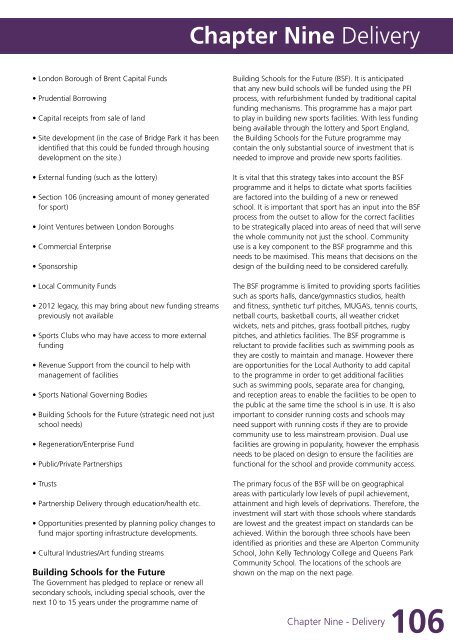



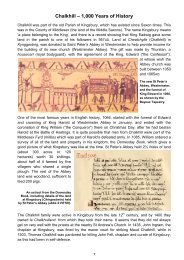
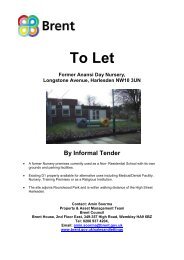
![0702012-khat[1] - Brent Council](https://img.yumpu.com/11457346/1/184x260/0702012-khat1-brent-council.jpg?quality=85)
